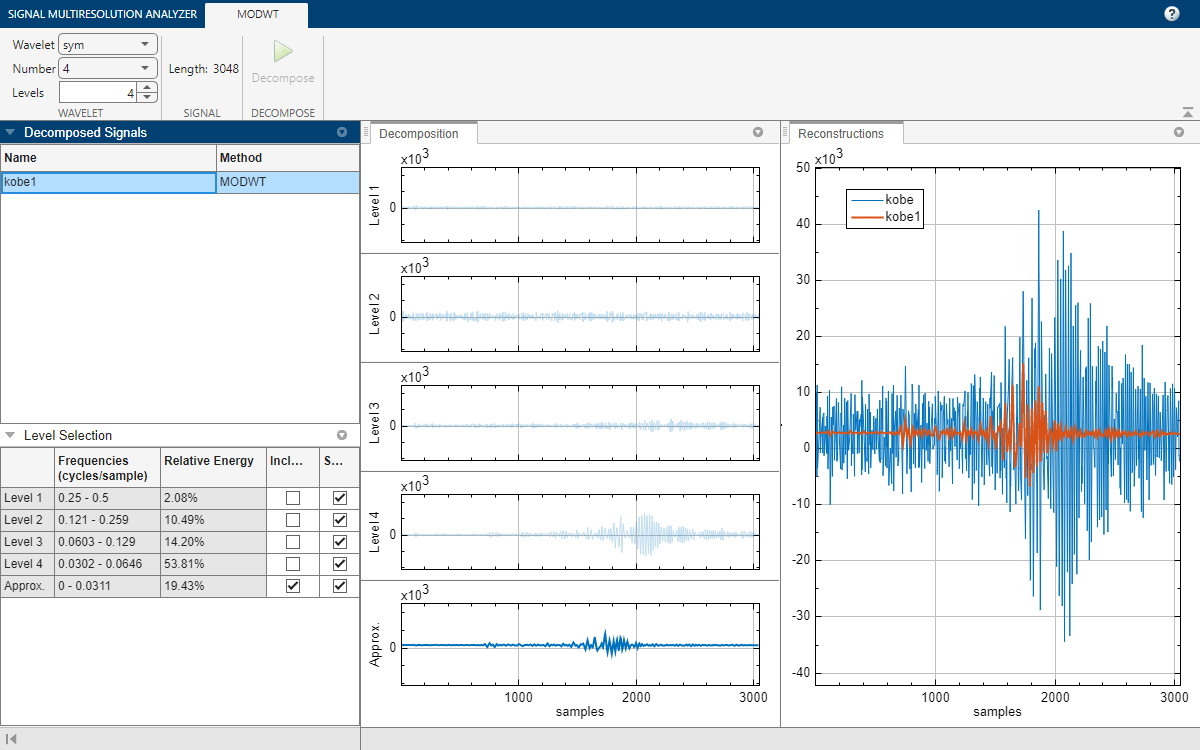Come iniziare a utilizzare Wavelet Toolbox
Wavelet Toolbox™ fornisce applicazioni e funzioni per l’analisi in tempo-frequenza dei segnali e l'analisi multiscala delle immagini. È possibile ridurre il rumore e comprimere i dati, rilevare anomalie, punti di cambiamento e transienti. La toolbox consente workflow di intelligenza artificiale (AI) incentrati sui dati, fornendo trasformate tempo-frequenza e l'estrazione automatica di feature, tra cui trasformate di dispersione, trasformate wavelet continue (scalogrammi), distribuzione di Wigner-Ville e scomposizione in modalità empirica. È possibile estrarre contorni e caratteristiche orientate dalle immagini utilizzando le trasformate wavelet, wavelet packet e shearlet.
Le applicazioni consentono di eseguire in modo interattivo l'analisi tempo-frequenza, la riduzione di rumore nel segnale o l'analisi di immagini, nonché di generare script di MATLAB® per riprodurre o automatizzare il lavoro.
È possibile generare codice C/C++ e CUDA® dalle funzioni della toolbox per la distribuzione integrata.
Tutorial
- Practical Introduction to Time-Frequency Analysis Using the Continuous Wavelet Transform
Perform and interpret time-frequency analysis of signals using the continuous wavelet transform. - Using Wavelet Time-Frequency Analyzer App
Learn how to use to visualize scalograms of 1-D signals and recreate results in your workspace. - Using Wavelet Image Analyzer App
Visualize discrete and continuous wavelet decompositions of images. - Practical Introduction to Multiresolution Analysis
Perform and interpret basic signal multiresolution analysis (MRA). - Analisi wavelet discreta
Analizzare e ridurre il rumore di segnali e immagini utilizzando le tecniche della trasformata wavelet discreta. - Using Wavelet Signal Analyzer App
Analyze and compress 1-D signals using wavelets. - Classify Time Series Using Wavelet Analysis and Deep Learning
Classify electrocardiogram data using deep learning and the continuous wavelet transform. - Deploy Signal Classifier Using Wavelets and Deep Learning on Raspberry Pi
Classify human electrocardiogram signals on a Raspberry Pi® using scalograms and a deep convolutional neural network. - Detect Anomalies Using Wavelet Scattering with Autoencoders
Learn how to develop an alert system for predictive maintenance using wavelet scattering and deep learning. (Da R2022a)
Analisi tempo-frequenza
Analisi multiscala
Tecniche wavelet nei workflow dell'IA
Informazioni sulle wavelet
- Che cos'è una wavelet?
Informazioni generali sulle wavelet e su come rilevare le discontinuità del segnale.
- Trasformate wavelet discrete e continue
Decidere se utilizzare una trasformata wavelet continua o discreta.
- Scelta di una wavelet
Apprendere i criteri per scegliere la wavelet adatta per la propria applicazione.
Esempi in primo piano
Video
Informazioni sulle wavelet, parte 1: cosa sono le wavelet
Scoprire i concetti fondamentali delle trasformate wavelet in questo Tech Talk introduttivo di MATLAB. Questo video spiega cosa sono le wavelet e come si possono utilizzare per esplorare i dati in MATLAB. Il video è incentrato su due importanti concetti della trasformata wavelet: la scalatura e lo spostamento. I concetti possono essere applicati a dati bidimensionali come le immagini.
Informazioni sulle wavelet, parte 2: tipi di trasformate wavelet
Scoprire in dettaglio il funzionamento delle trasformate wavelet. Si apprenderanno ulteriori informazioni sulla trasformata wavelet continua e sulla trasformata wavelet discreta. Si apprenderanno inoltre importanti applicazioni di utilizzo delle trasformate wavelet con MATLAB.
Informazioni sulle wavelet, parte 3: un esempio di applicazione della trasformata wavelet discreta
Apprendere come utilizzare le wavelet per ridurre il rumore in un segnale preservandone le feature maggiormente evidenti in questo Tech Talk di MATLAB. Questo video illustra le fasi di riduzione del rumore in un segnale con trasformata wavelet discreta utilizzando MATLAB. Apprendere come questa tecnica di riduzione del rumore si rapporta ad altre tecniche di riduzione del rumore.
Informazioni sulle wavelet, parte 4: un esempio di applicazione della trasformata wavelet continua
Scoprire un'applicazione pratica dell'utilizzo delle trasformate wavelet continue in questo Tech Talk di MATLAB. Ottenere una panoramica su come utilizzare MATLAB per ottenere un'analisi tempo-frequenza più nitida di un segnale con trasformata wavelet continua. Questo video utilizza un esempio di segnale sismico per evidenziare le capacità di localizzazione in frequenza della trasformata wavelet continua.
Informazioni sulle wavelet, parte 5: Machine Learning e Deep Learning con dispersione wavelet
Le reti di dispersione Wavelet consentono di ottenere automaticamente feature a bassa varianza da segnali e immagini da utilizzare nelle applicazioni di Machine Learning e Deep Learning. In questo Tech Talk di MATLAB, si scoprirà la trasformata wavelet di dispersione e come può essere utilizzata in qualità di estrattore automatico e robusto di feature per la classificazione.









